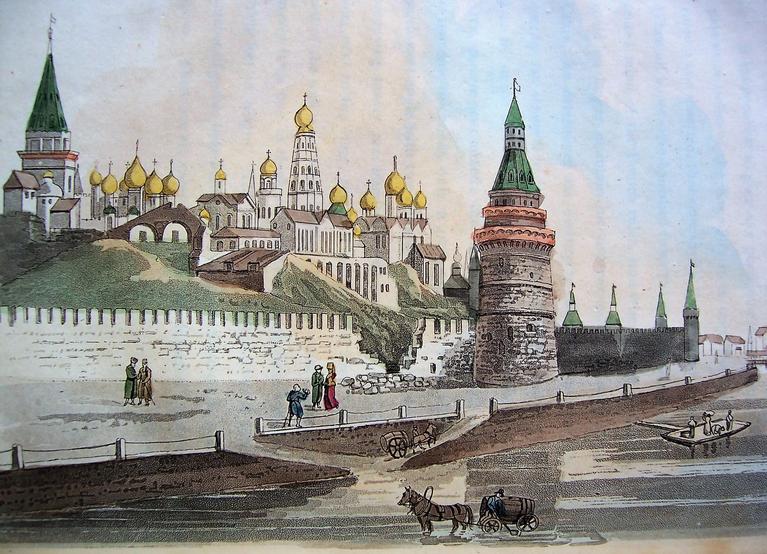Blog
9 March 2022

Russia – in its difference, in its vastness – has always been in every century an object of some fascination, and there are far more books about Russia by British authors in Emmanuel’s collection of illustrated books than can be described here. By contrast – since rare books produced in Russia by Russians do not much figure in the College library – it is all the more precious that Emmanuel has possessed since 1749 a copy of the first book on mathematics by a Russian published in Russia, the Arifmetika (Moscow, 1703) by Leontii Magnitskii (1669-1739), who was appointed by Peter the Great to his new School of Mathematics and Navigation in 1701 and ordered to produce a textbook.
.jpg)
.jpg)
Plates 2 and 3: Leontii Magnitskii, Arifmetika (Moscow 1703): Arithmetic enthroned in the Temple of Learning. Addition, Subtraction, Multiplication and Division are inscribed on the steps to the throne;
Emmanuel’s collection includes a whole clutch of early nineteenth-century books illustrating the costumes worn by the Tsar’s racially diverse subjects across his far-flung empire. Not for nothing does the title page of one such book show St Petersburg’s towering bronze equestrian statue of Peter the Great, atop its seventeen-feet-high granite rock.
.jpg)
.jpg)
Plate 4: E. Harding, The Costume of the Russian Empire (1811), Title Page; Plate 5: Harding, The Costume: Inhabitants of the Aleutian Islands;
The Tsar’s vision of a Russian empire is everywhere implicit, and it stretches to the inhabitants of islands at Russia’s far eastern reach, as well as to what are now the Baltic Republics and Finland.
But the vogue for such costume books aims at more than recording clothes, and the accompanying texts use regional and national dress as their way into commenting on wider customs and culture.
.jpg)
.jpg)
Plate 6: W. Miller, The Costume of Russia (1800): A Woman of Estonia; Plate 7: Miller, The Costume: A Khirgiz;
So here is a ‘Woman of Estonia’ in her colourful finery, and a mounted Khirgiz from Central Asia, whose ‘chief employment is robbery and plunder’.
One of Russia’s many ‘extremes’ that made it so interesting was its extreme climate, so that the sub-title of a handsome illustrated book about St Petersburg boasts of its ‘Interesting Views of the City, the Sledges and the People’, and illustrates a range of vehicles for getting about in the snow.
.jpg)
.jpg)
Plate 8: A Picture of St Petersburg (1815): A Winter Travelling Carriage; Plate 9: A Picture: Sledge of a Russian Citizen;
A very ambitious and beautiful illustrated book is J. A. Atkinson’s monumental The Manners, Customs and Amusements of the Russians (1803-4), with soft-ground etchings washed with colour. It includes plates illustrating aspects of the Russian economy, such as the annual frozen meat market in St Petersburg. With the arrival of winter, farmers slaughter all but their breeding stock and place the meat in the open air to freeze. Fish and game are also frozen. The meat is then brought in huge quantities to St Petersburg just before Christmas and sells at 30% cheaper than fresh meat.
.jpg)
.jpg)
Plate 10: J. A. Atkinson, The Manners, Customs and Amusements of the Russians (1803-4): The Market of Frozen Provision; Plate 11: The Manners: Imperial Festival;
Also illustrated are Russian traditions, such as the Imperial Festivals that mark the weddings of members of the Imperial Family. Outside the palace large reservoirs spout red and white wine into basins. Concealed inside crimson damask tents are pyramids of roasted geese, ducks, hams, each surmounted by a whole roast bullock (their horns can be seen peeping through the tops of the tents). The crowds are kept penned until the Imperial Family appears on the balcony, whereupon a signal is given and the assembled mob fall on the mounds of food and carry them off.
Russian pastimes and customs are the subject of other plates. The text observes that ‘Sliding down an artificial hill of ice is a favourite diversion of the Russians in winter … Not a village or hamlet is without them’. The scaffolds are about thirty-five feet high, with steps ascending to a slide of ice at a 45 or 50 degree angle. A ‘guide’ waits at the top seated on a kind of toboggan. The customer then sits on top of the guide(!), who duly pushes off and both slide down together.
.jpg)
.jpg)
Plate 12: The Manners: Ice Hills; Plate 13: The Manners: Steam Baths;
The Russian love and weekly use of steam baths receives careful explanation. In the public baths, found in cities near rivers, ovens heat separate rooms for male and female bathers, and also heat the iron balls and stones on to which water is flung to fill the bathing room with steam. Bathers lie on elevated benches six feet from the ground and two or three feet below the ceiling, where the steam is thickest. The skin is rubbed with bundles of birch twigs before plunging into the river or rolling in snow, passing through extremes of temperature that are ‘a thing hardly credible’ to the British author.
Also illustrated is one of the villages dotting the vastness of the Russian Empire, usually set out as one long street of houses with steeply pitched roofs. Villages that belong to the Crown are reported to fare better than those subject to taxation by the local nobility, where an ‘air of poverty and wretchedness pervades’.
.jpg)
.jpg)
Plate 14: The Manners: A Russian Village; Plate 15: The Manners: Ukrainian Drovers
So few references are to be found to Kyiv and to Ukraine that they were evidently not usually on the trail followed by early nineteenth-century British visitors to Russia, but here in closing is one glimpse of Ukraine in a plate showing Ukrainian drovers, who were accustomed to drive their herds of large cattle all the way to market in Moscow and St Petersburg.
Slava Ukraini! Glory to Ukraine!
Barry Windeatt (Keeper of Rare Books)
Images by Helen Carron (College Librarian)
